Urban and jangly, the small city of Iquitos, Peru is smack dab at the edge of the Amazon river basin. This most surreal of cities just stretches out into the great beyond known as the Amazon. Equatorial Iquitos is hot, muggy and buggy all year round. With a population of 500,000, Iquitos is the perfect counterpoint to the calm depths of the Amazon.
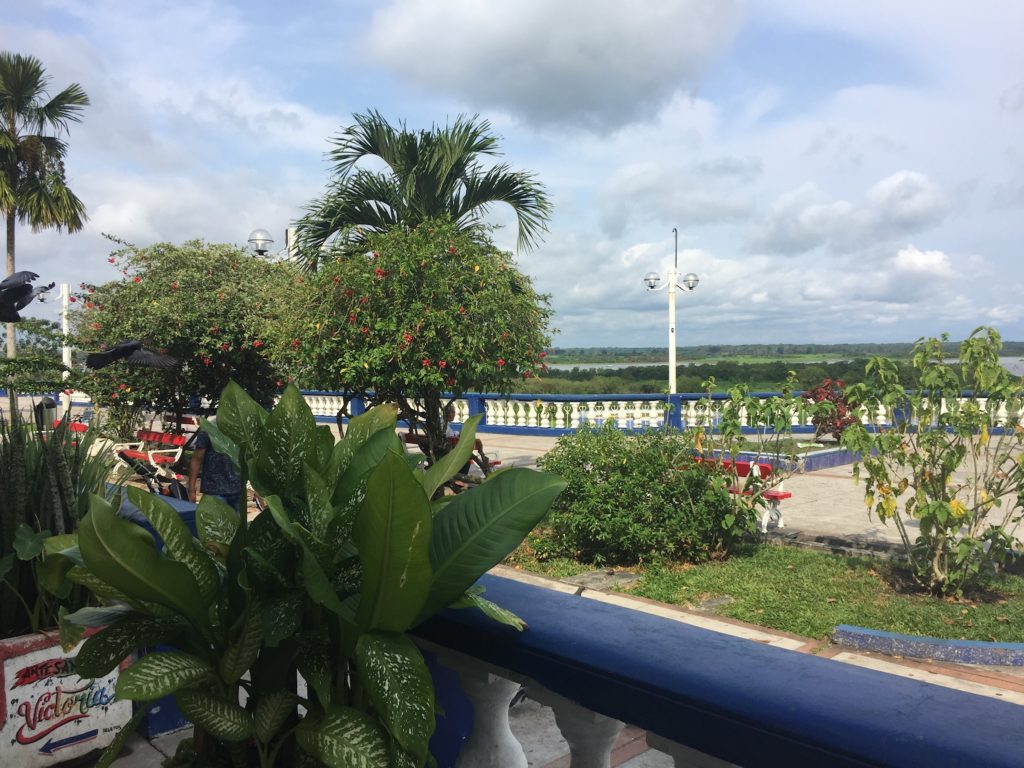
December 2022 Iquitos is a bizarre slurry of small towns and neighborhoods that roll up into a population center of a half a million people. Iquitos smashes up against, and oozes out across the Amazon, that most famous river jungle. Every fabulous story you ever heard about the Amazon is true, and more. And now you will hear the other half of the Amazon story, the odd urban counterpoint to the jungle calm.
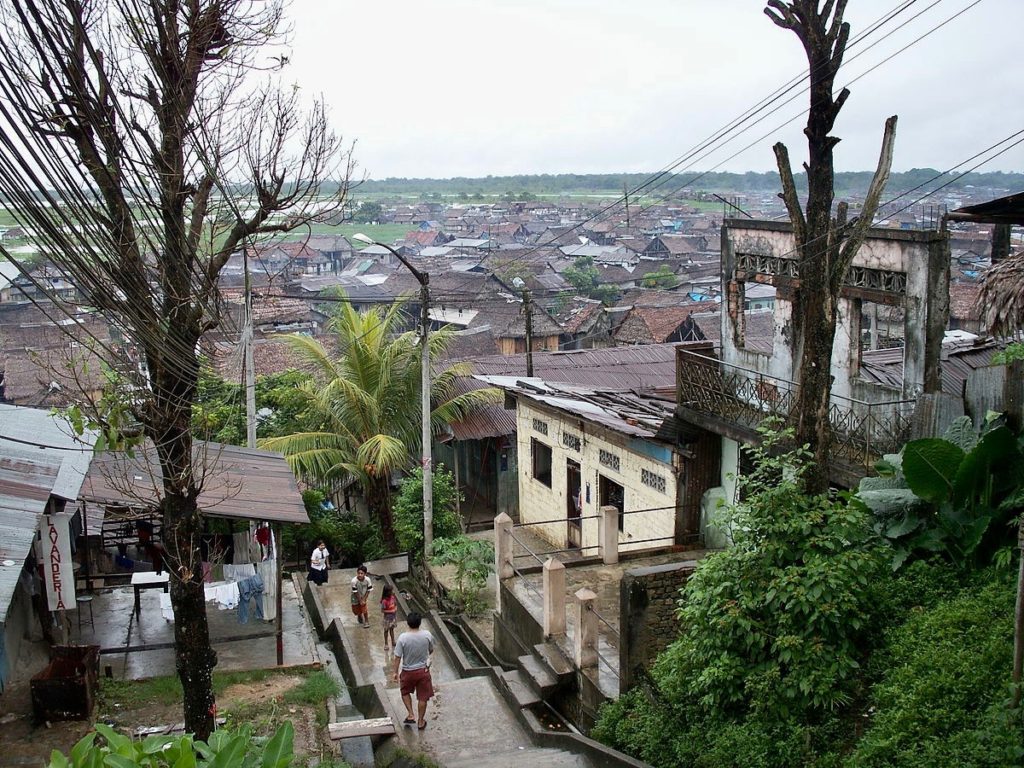
Here are three fun facts that make Iquitos the most unique city in the world. The first fact is that Iquitos, built on the edge of an interior jungle, is actually a port city — the farthest inland port in the world. Iquitos is the harbor port for the Atlantic Ocean some 2,000 miles upriver. The port infrastructure was built to transport rubber, lumber and other Amazon resources out of the Amazon and into the Atlantic. Second, there is no road to Iquitos making it the world’s largest land-locked city. The city is indeed landlocked, but also water logged. Surprise, you can get to Iquitos by Amazon river steamer; or thank goodness for modern times, you can now hop a short plane flight from the Lima, the capital of Peru. However, there is one paved road out of Iquitos. The road ends a few miles away in the neighboring town of Nantua, a river town and jumping off point for Amazon river traffic. Nantua itself is also landlocked. There are cars and trucks in Iquitos (and Nantua), but not many. All cars and trucks are shipped into Iquitos on Amazon river steamers. The whole region runs on mototaxis, not cars. Third, Iquitos is the most isolated city in the world. The nearest large town is Pullcalpa, 330 miles away. These three fun facts are all obviously interrelated, but combine to make Iquitos one wierd place to live, compared to the rest of the 21st century world. As just a small “say what” example of how isolated is the city of Iquitos: There are NO international chain businesses on the street. There is not a Starbucks nor a Circle K nor a Hertz car rental in this metro area of over a half million people: not a Kentucky Fried Chicken or a McDonalds from horizon to horizon. There is now one store-front, western corporation. The first franchise hotel opened in 2019, a Doubletree hotel, part of the Hilton chain. Doubletree is the only premier hotel in Iquitos.
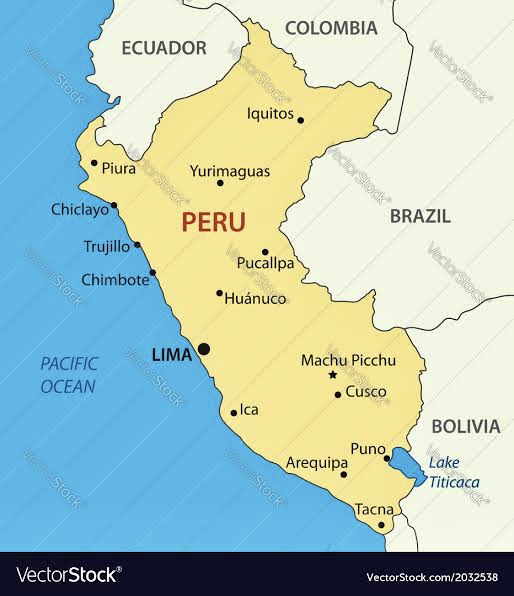
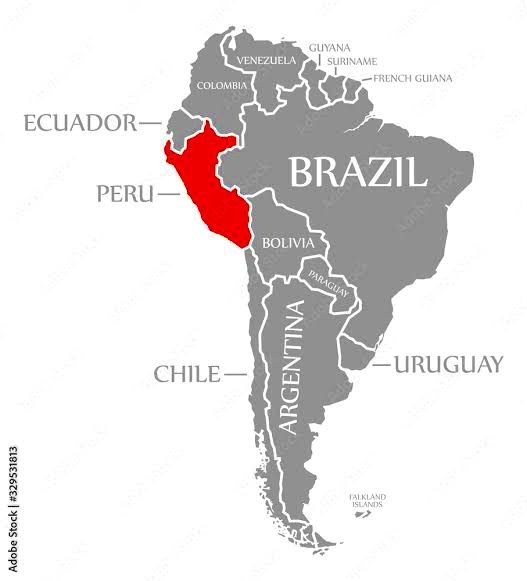
An Overview of Iquitos: The Surreal Mixed With Squalor
Iquitos is a Heady Combination of Filth ……
Posted December, 2022. The Iquitos presented here may look picturesque. This idyllic view is especially true considering that there are few big, ugly cars around: just charming little golf carts puttering by. This writer stayed in Iquitos for one month in September 2019 during the height of the dry season. The daily reality was not post-card perfect. The truth on the ground, and in the air, was much different. All observers note the endless noise and air pollution of the ever present golf carts converted into mototaxis. Take a motorcycle with NO MUFFLER and NO EXHAUST SYSTEM and attach it to a golf cart to create a three wheeled mototaxi. Imagine thousands of ceaseless “gentleman start your engine” noises from engines spewing out toxic fumes as the mototaxis run amok everywhere in the main sections of Iquitos. Toss into this urban soup the potholes and poorly maintained roads; endless amounts of road littering; strewn garbage; blowing street grit; plus animal filth and the ocasional carcass from all the ferals. This writer was okay in Iquitos for the first five days or so. After that, he had low level-headaches, a queasy stomach, and standard allergy-like respiratory symptoms all day, everyday. He suffered from the combustible mixture on the street: noise pollution, toxic fumes, foul odor, and visual filth; plus the extreme heat and humidity of equatorial Amazon. Only the high end hotels had hot-water showers. Why would you need to pipe in more hot water into the Amazon river basin?
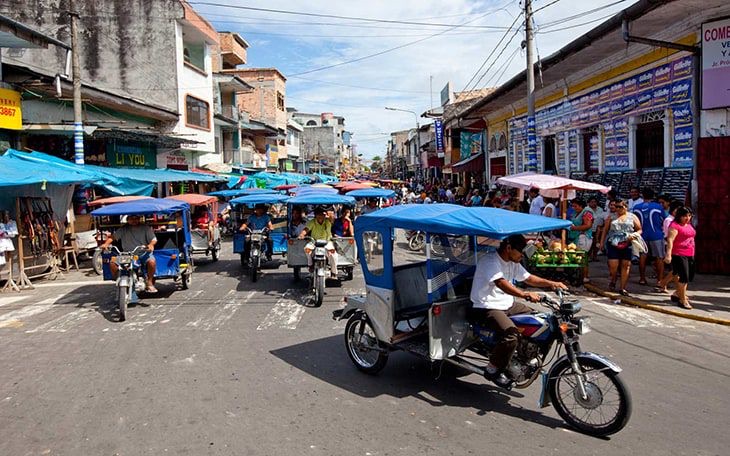
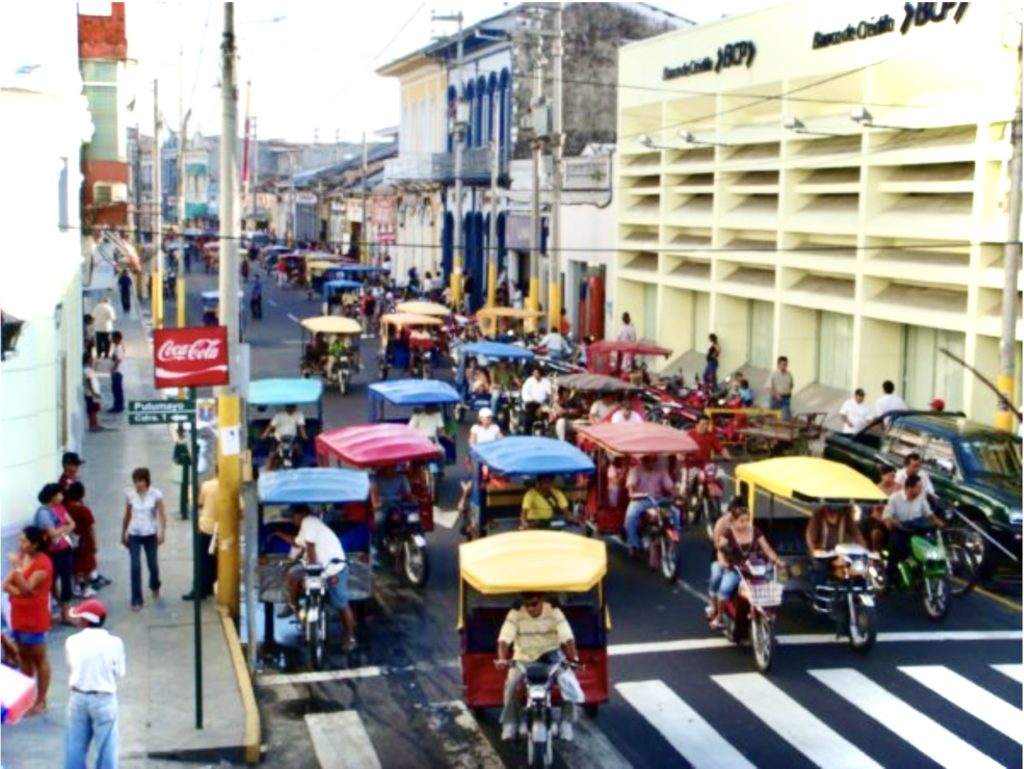
…… and Charm
There are many nuggets of tourist delight in Iquitos, no doubt about it. New York Times reporter Nina Burleigh said it best when she wrote of her kalaidescope adventures touring Iquitos:
“In Lima, [Peru’s capital city] before I left for the Amazon and its jungle, I lunched with a Peruvian political leader who warned me that Iquitos is “kind of a hellhole,” but I found it rather charming. It is the perfect destination, in fact, for those who like their steamy romantic hideaways with a little mayhem.”
https://www.nytimes.com/2013/09/15/travel/iquitos-peru-wet-and-wild.html?se
Reporter Burleigh continued: “Before we begin, a disclaimer: In Iquitos, Peru, your correspondent did not consume the shamanic hallucinogen ayahuasca. This is despite having seen candy-colored motorcycle-pulled carriages, Volkswagen-size sinkholes, the lost jungle Eiffel Tower, the gentleman pushing a life-size red-and-gold merry-go-round horse up a lime neon-lit edge of an avenue and the woman stopping traffic at midnight with a pompom routine, and heard the tinny soundtrack of cuckoo-clock church bells straight out of the Twilight Zone marking every quarter-hour.”
“The surreal is simply real in Iquitos, the proud “Capital of the Amazon.”
“I stumbled into town after seven days floating up the Amazon and its tributaries, hiking the jungle, meeting tarantulas and anacondas, watching pink dolphins frolic in the brown swill of the great river, and guzzling cocktails of the supposedly aphrodisiac herbal jungle brandy called 21 Raices. Iquitos seemed more urbane at that moment than it might have fresh off a plane from New York.”
Reader’s Choice: Is this picture below an example of Iquitos’ squalor or charm?
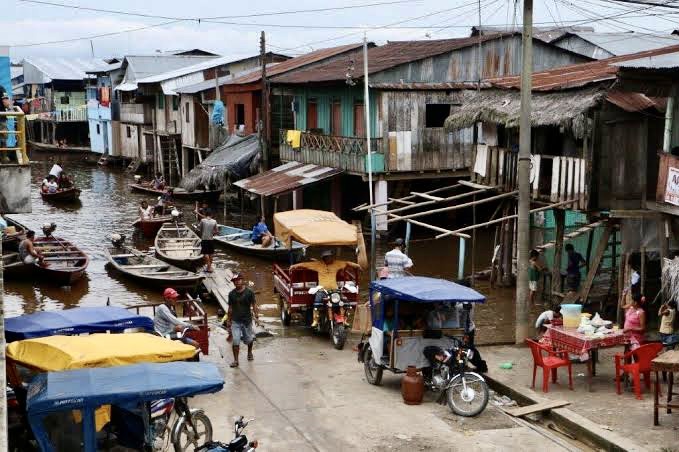
Three Sections of Greater Iquitos: Main Plaza, Belen Waterpark and Nearby Nanty
There are four main areas of Iquitos town; and some outlying, varied “suburban” areas. This section will highlight the two most distinctly different parts of Iquitos proper, and then skip over to neighboring area of Nanay.
Going Downtown? Head to Iquitos Town Square – the Plaza de Armas
Like all good Latin American towns, Iquitos is centered around a main, park-like plaza, called a “plaza de armas” in South America. Iquitos has a charming, park-like, plaza de armas as the downtown bulls eye. The plaza is ringed by Iquitos’ main enterprises: historic buildings, a only luxury hotel (DoubleTree), a cathedral, and pleasant little shops including several blessed ice cream parlors. In the Amazonian heat and humidity, nothing is more welcome than an ice cream cone.
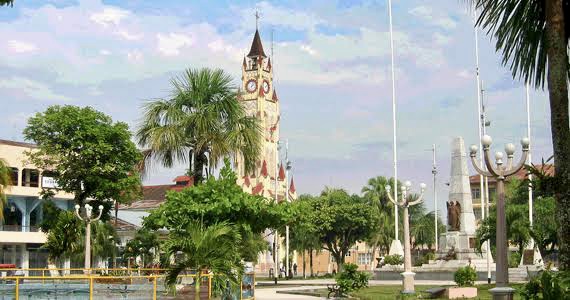
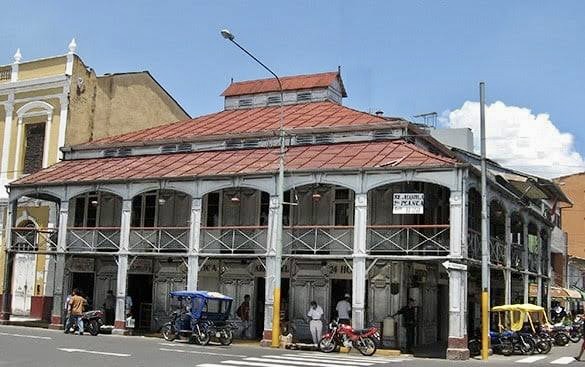
Welcome to Belen – Catch a Fish on the Boat Ride Home. Grab a Fishin’ Pole and Jump In
As mentioned, the town of Iquitos consists of four separate district, each with its own ….. ambiance. Immediately adjacent to the main downtown plaza area, is the district of Belén. This neighborhood is known for its massive, open-air street markets, and rustic stilt houses all lining the Itaya river, a tributary of the Amazon. During the dry season, these homes and shops are perched on ten to fifteen foot tall stilts. People climb rickety stair from the dirt road up to the entrances. In the rainy season, they get home by following the instructions of their driver: “Step right up, ladies and gentleman, straight from the the river taxi to your front door. Please don’t rock the boat.”
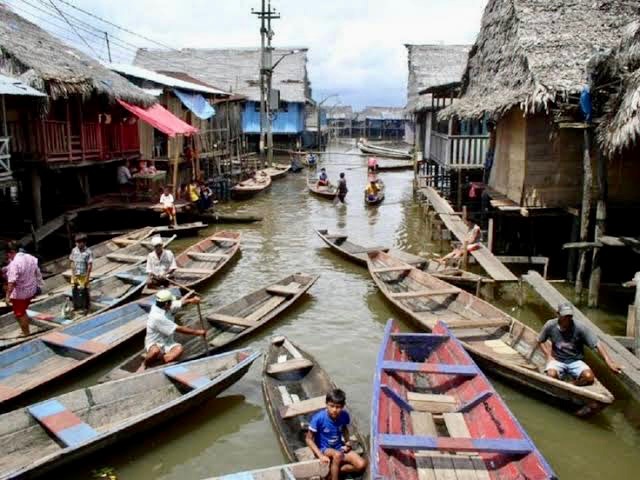
The waterways of Belen have been compared to the riverine streets of Venice. However, Belen is so much more… and so much less.
Head Over to Nanay Port for the Freshest Fish …. and Bugs
Nanty Port is a river hamlet on the outskirts of greater Iquitos. It is a quiet spot to get very fresh fish or other local delicacies. Nanty also has a tiny harbor to service boats and sea planes, big and small, that ply the Nanay River.
These photographs below are from the waterfront market and restaurant area on the Nanay River, a major tributary of the Amazon. These photographs were taken at the end of the dry season and the rivers have shrunk. I am told the shallow river banks will DRAMATICALLY swell up with water. Much of the now dry river valley will be underwater for many months. Thus, the riverside grassland, bushes and trees seen in these photos will be underwater, or at least inundated. The buildings and structures all float or are perched on stilts.
Photographs immediately below taken from Nanay marketplace perched high up, overlooking the river. The photograph on the left shows a child pointing to skewers of suri – the local palm tree beetle grubs that are ready for the grill. This writer saw suri listed on local restaurant menus complete with accompanying photos. In the middle is a picture of a local fish restaurant. On the right is local housing.
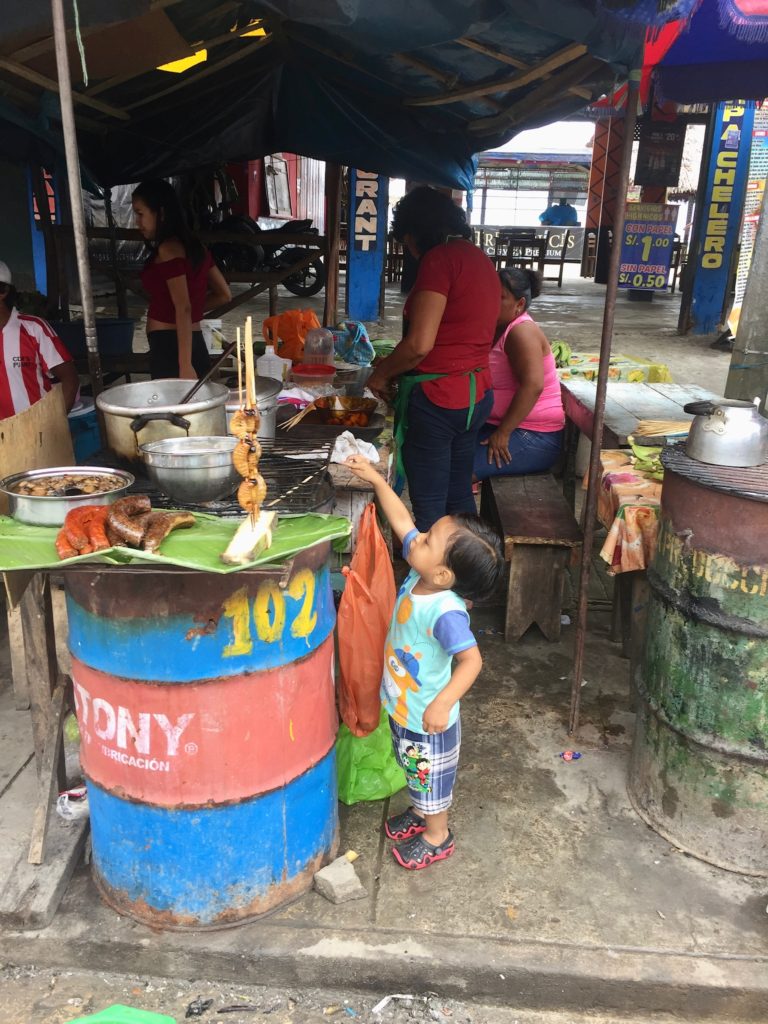
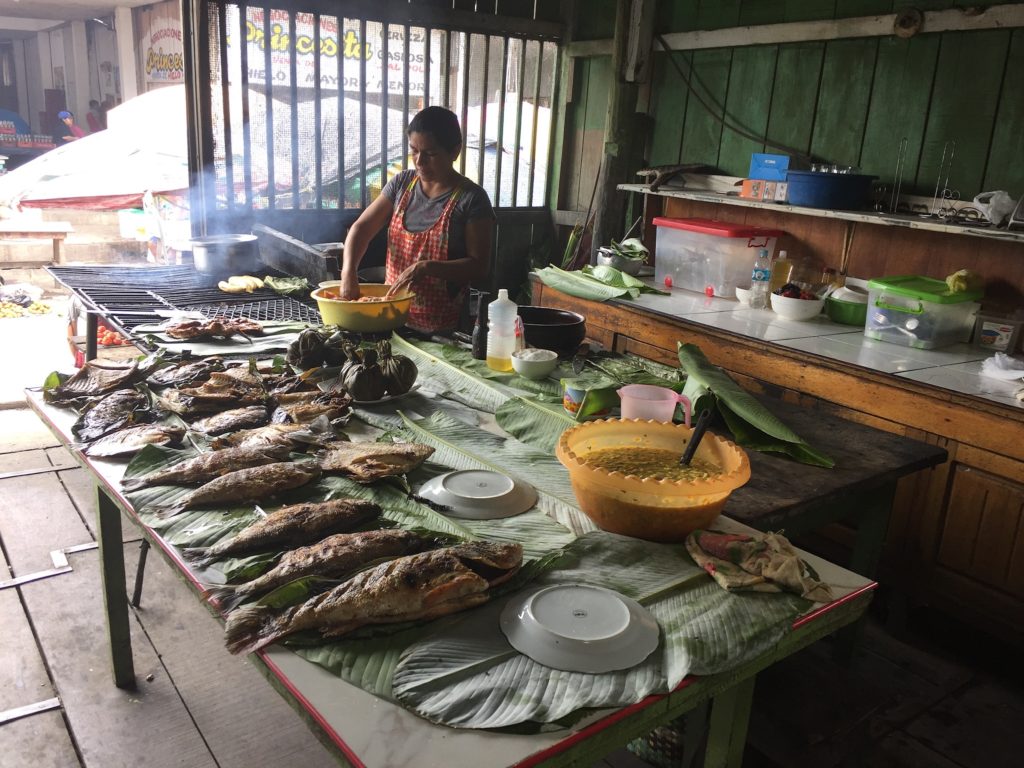
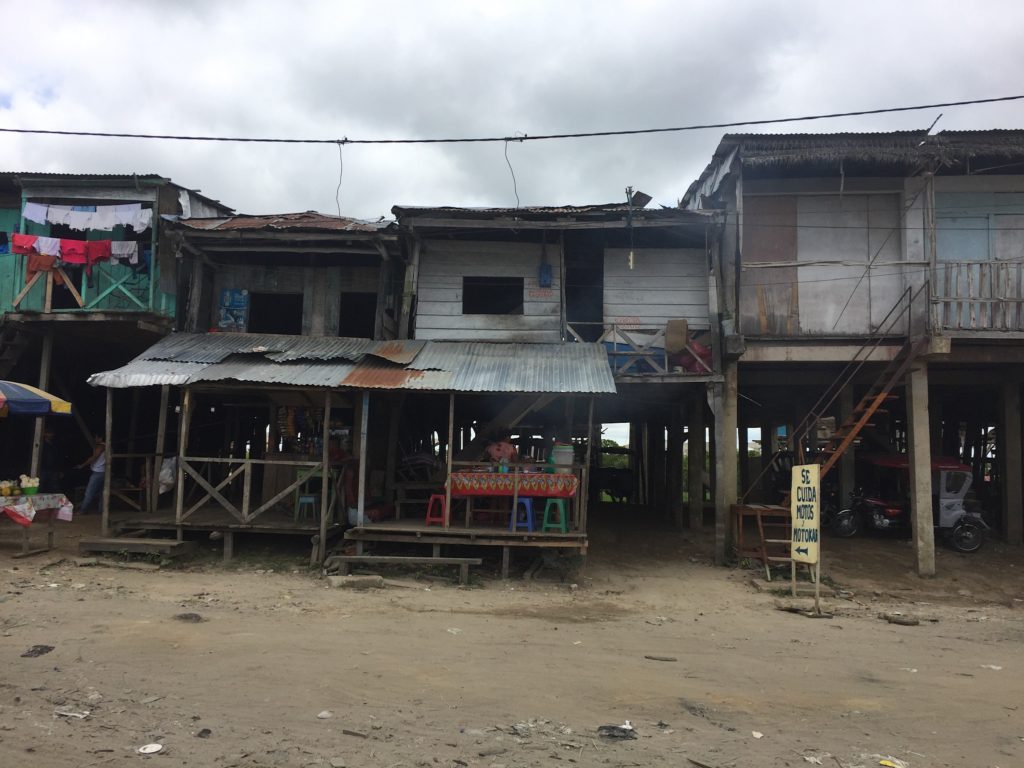
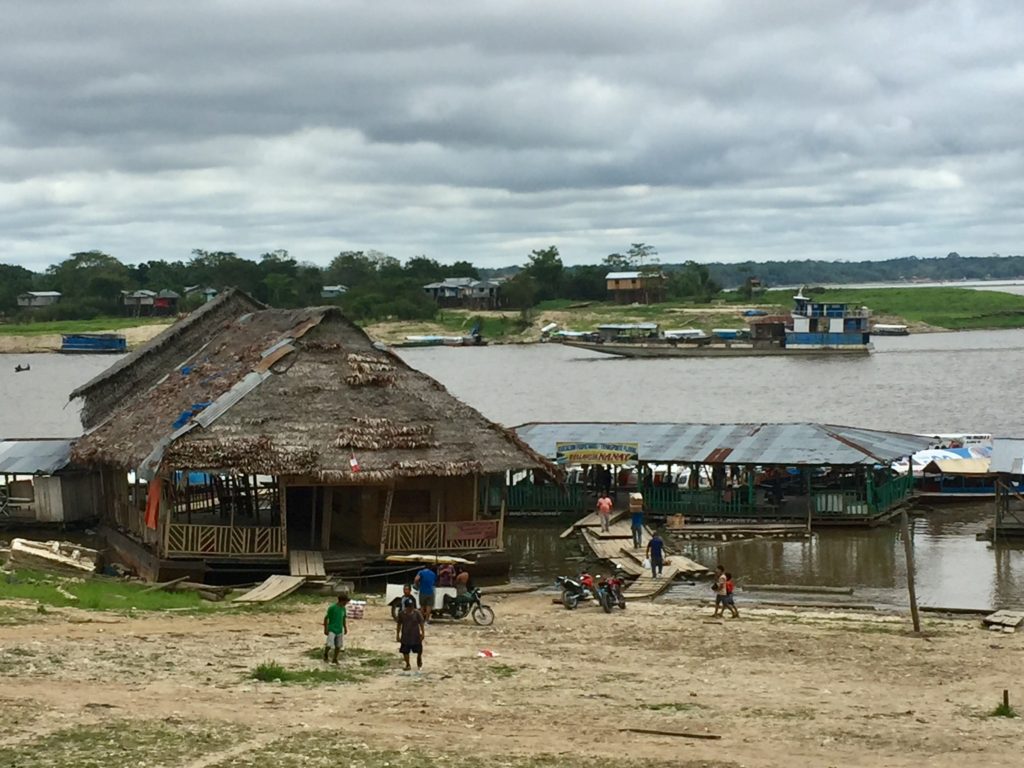
Above: Nanay harbor front restaurant and supply station. The writer’s assumption is that all these structures freely float up to clear the rising water lines during the rainy season.
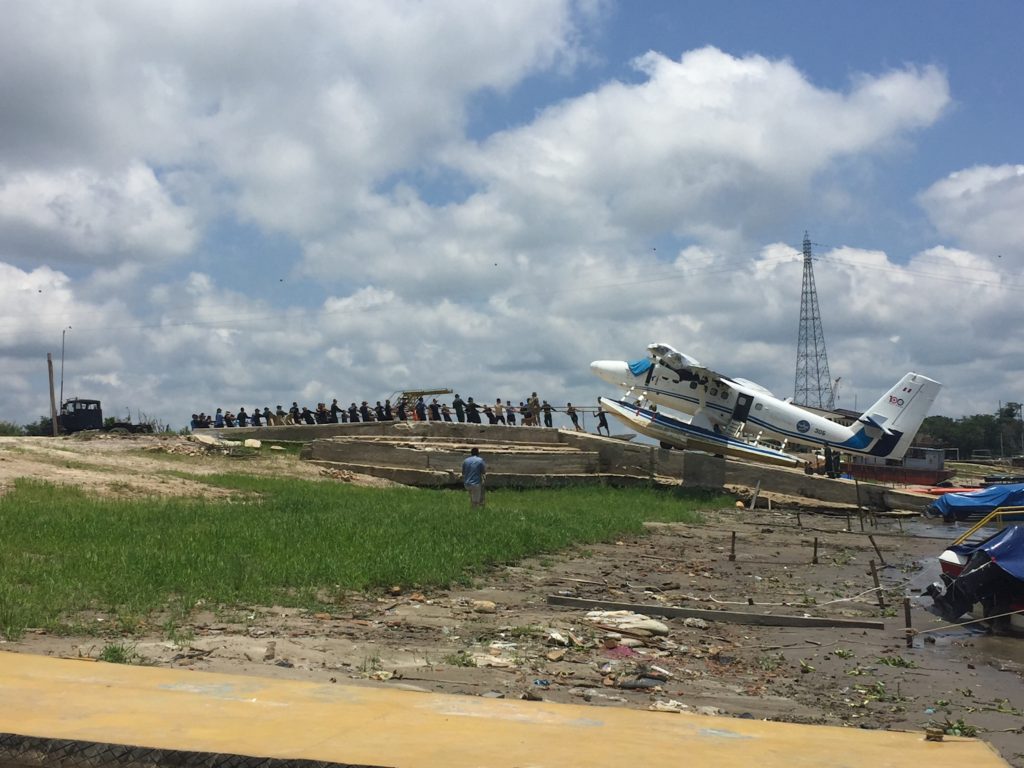
Iquitos is Famous for: Rubber, the Movie “Fitzcarraldo” and Ayahuasca
Iquitos was the Home Town of the Rubber Barons
The Amazon has more rubber trees than anywhere else in the world. Rubber, a vital component of the Industrial Age, was extracted in large quantities from the Amazon; then shipped over to Europe and the U.S.A. In the Peruvian side of the Amazon, the regional hub for everything rubber was Iquitos. The road from Iquitos to Nauta and the entire Iquitos port was constructed to facilitate transport of rubber as well as timber, oil and other extraction resources. By the 1920’s, the Amazon rubber craze subsided. The headquarters of rubber extraction moved to places like India and the Philippines. Later, the introduction of synthetic rubber ended rubber extraction industry worldwide. By mid twentieth century, the whole global economy has shifted away from a focus on what the Amazon basin has to offer. Thus, since World War II, the industrial world no longer needs Iquitos. This whole region has been on an economic backward slide for decades now.
Iquitos was all about the Rubber
To this day, the now crumbling mansions and abandoned social clubs of the local Rubber Barons speak to the town’s vibrant commercial past. The rubber-based, Guilded Age of Iquitos ran from about 1879 to 1912.
To this day, the now crumbling mansions and abandoned social clubs of the local Rubber Barons speak to the town’s vibrant commercial past. The rubber-based, Guilded Age of Iquitos ran from about 1879 to 1912.
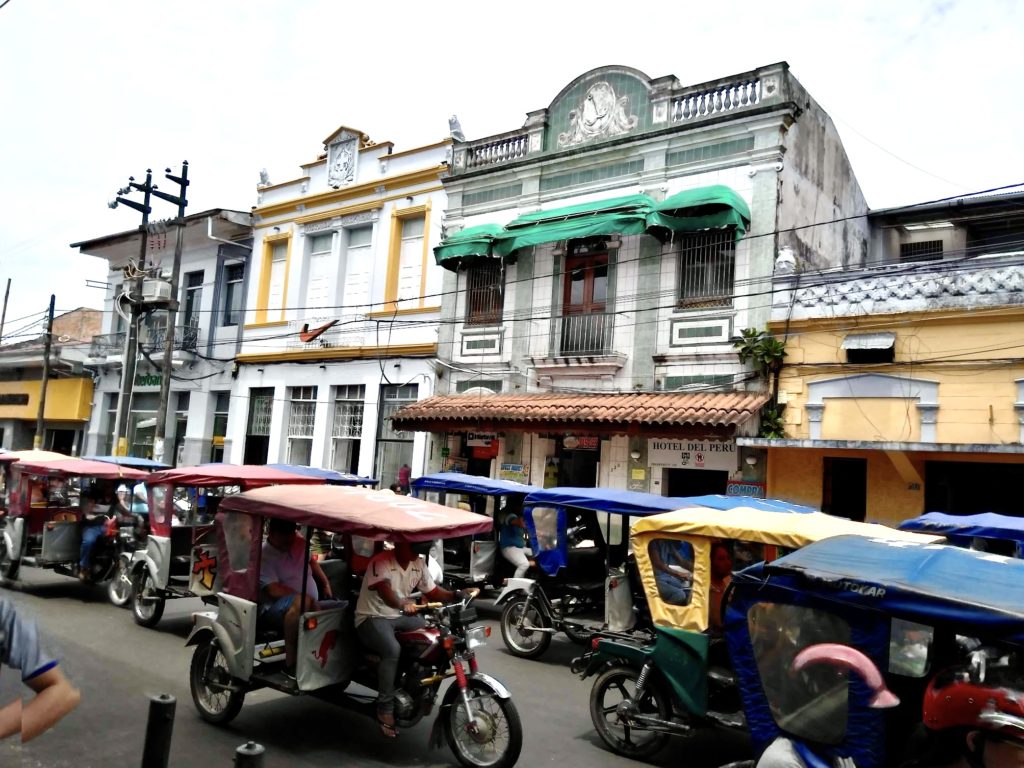
The story of a beleaguered Rubber Baron who craved bringing the opera to the Amazon lives on in the movie “Fitzcarraldo,” by filmmaker Werner Herzog. Nowadays, Iquitos is not the center of vital components for industrial society. However, Iquitos has been repurposed as the center of vital components for mind expanding society: Ayahuasca and other hallucinogenics, described below.
The Rubber Bounce: Charles Goodyear was a chemist and manufacturing engineer who developed vulcanized rubber using heat and chemical treatment to stablize natural, organic rubber. In 1844, he received a patent for this critical component of modern industry. Automotive tires, pencil erasers, life jackets, balls, gloves, waterproof shoes and more, all came from rubber. But it came at the cost for the Amazon rubber workers of their health, home town, and even their lives. The Amazon locals became near slaves to tap the native rubber trees on a scale that ripped up the local environment. The tribes and their homelands have not recovered to this day.
“From the 1890s to the 1920s rubber from the Peruvian jungle was in high demand. Foreign companies settled in the city of Iquitos, Peru from where they controlled the extraction of rubber. In 1851 Iquitos had a population of 200 and by 1900 its population reached 20,000. In the 1860s, approximately 3,000 tons of rubber was being exported annually and by 1911 annual exports had grown to 44,000 tons, representing 9.3% of Peru’s exports.”
“Thousands of native Indians worked as rubber tappers, removing the sap from the trees. They worked in harsh slavery conditions and they were not paid fairly. They were also the victims of foreign diseases that killed about 40,000 native workers.”
“By the end of the 1920s rubber was being produced cheaper in Ceylon and India, English companies moved their production to these locations and abandoned the Peruvian Amazonian jungle bringing the rubber boom to an end. Hundreds of local families were plunged into poverty.” This quoted section taken directly from: http://www.discover-peru.org/peru-rainforest-rubber-boom/
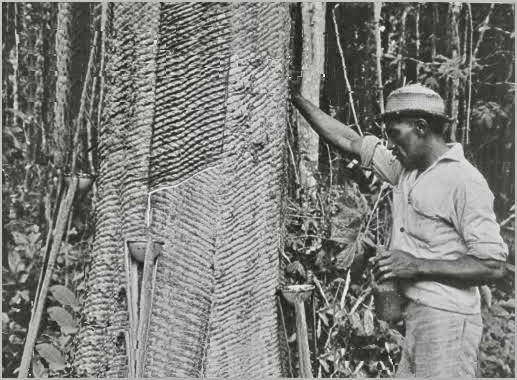

The 1982 Movie “Fitcarraldo” Celebrates the Iquitos Rubber Era
The German filmmaker, Werner Herzog, made a movie based on a true story about an obsessed wealthy European living in Iquitos during its Gilded Age. The title character Fitzcarraldo, whose name in real life was Brian Sweeney Fitzgerald, was desperate to bring an opera house to Iquitos. Fitzcarraldo went to extraordinary lengths to realize his obsession of having classical music performed in the Amazon. Here is a three minute synopsis of both the film and its principal participants — Werner Herzog and lead actor, Klaus Kinski who played Fitzcarraldo:
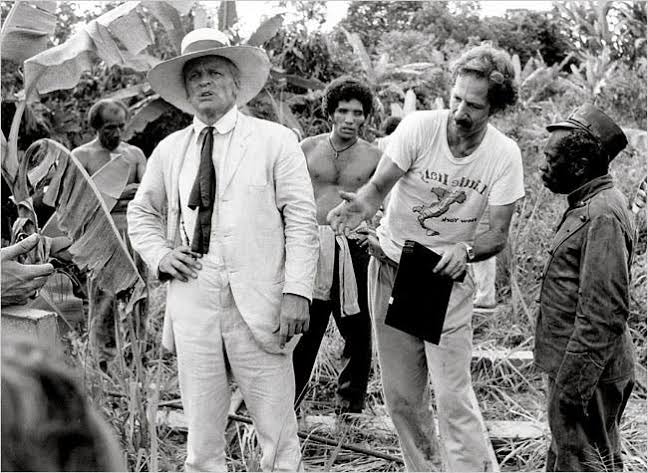
Herzog was completely obsessed with everything about Fitzcarraldo: the story, the Amazon, and the making of this movie. Herzog started filming in a different part of Peru. Herzog and this production company had huge conflicts with the local tribes. The natives eventually burnt down the film crew’s camp and bundled its workers and equipment into three canoes. The natives unceremoniously shoved Herzog and the crew off into the Amazon river. Herzog did not give up – he just had to find another playground in which to realize his Amazonian fantasies. The natives in both the original location and the replacement setting of Iquitos were upset for many reasons. The tribal locals were so upset as one thousand members were hired as extras with little to no pay, and terrible working conditions. They were not told that their job included pulling a full-sized, functional steamboat up a mountain trail and down the mountainside to reach the Amazon. But first, the tribal workers had to cut the trail out of the virgin forest, a job project also not disclosed at time of hiring.
Overall, everyone, including Werner Herzog, hated working with the notoriously arrogant and insufferable lead actor, Klaus Kinski. He fought with everybody. At one point, the tribal chief offered to have Kinski just disappear in the woods, and his body would never be found. Herzog considered this tempting offer but then realized that he would have to reshoot all the Kinski scenes with a new lead actor. Werner turned down the proposal.
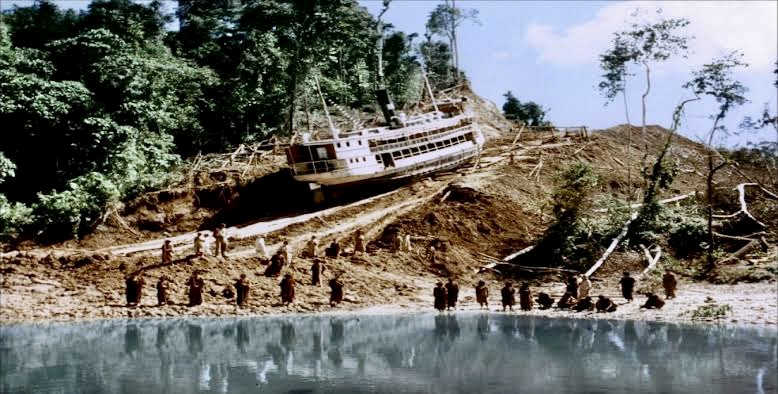
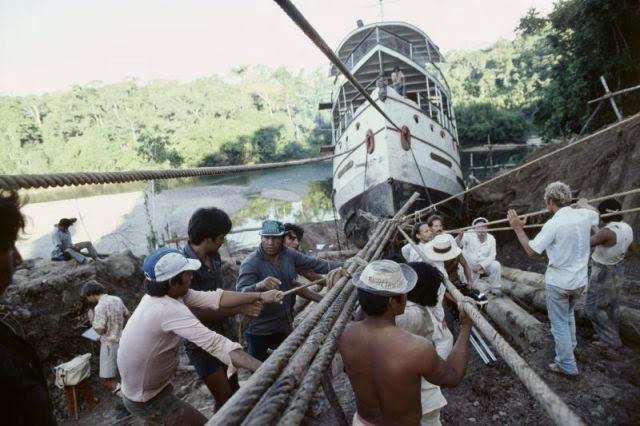
Much later in the filming, another Indian, his wife, and daughter were attacked near the film site by an unfriendly local tribe, the Amahuacas. The man was shot through the neck by a five-foot arrow and his wife was badly wounded in the hip.The attack was only one of a catalogue of disasters, including two plane crashes – in which five people were critically injured, one paralysed – and the death of a young highland Indian who drowned after borrowing a canoe without permission. Among more than a thousand extras, a few perished from disease – though arguably not as many as might naturally have done so without the presence of the production’s camp doctor.
Iquitos is Now the Home Base for Hallucinagenic Tourism
Iquitos is the destination of choice for tourists seeking jungle hallucinogens. Ayahuasca — the latest “alternative shaman cure” or “psychedelic binge craze” — is headquartered in Iquitos. There are guides, resorts, ashrams, homestays, “third-eye centers” aplenty; and a rare huckster or two. Iquitos is the center of a hospitality industry that caters to divergent clientele; both seekers of psychic enlightenment or the head-banging set of trippy tourists, all of whom seek out hallucinations. Ayahuasca is sort of like peyote in the 80’s for those who remember Carlos Castenada and “The Teachings of Don Juan” (1968). Devotees refer to Ayahuasca as the Medicine Way. Ayahuasca, while not a household word yet, has been generating increasing street cred and good buzz in American culture, just as it has for decades in the American counter-culture.
Ayahuasca is going mainstream for self-exploration, therapy, and flat-out entertainment. Psychiatrists and other western medical types are now studying ayahuasca for its’ great healing potential — for addiction; depression; all sorts of stir-crazy problems; emotional baggage generally; ezcema — who knows what? Ayahuasca therapy has many advocates. Oddly enough, some military-support organizations are leading the way. One of the many ayahuasca-as-therapy advocacy groups is Heroic Hearts Project. The Heroic Hearts Project has a clear focus as set out in its’ website banner headline: “If you actually want to support the troops, support psychedelic research.” The details about the Heroic Hearts psychedelic treatments is summarized by this writer —- “Heroic Hearts takes veterans with PTSD to the Amazon, and we all drop ayahuasca. You would be surprised, it helps a lot.” (NOT a quote from the website) For more information about this great group, see https://www.heroicheartsproject.org/
In addition to ayahuasca, there are also other psycho-active activities available in the Iquitos area including kambo, the hallucinogenic secretions from the skin slime of a certain Amazon frog; and even wachuma, from the Peruvian San Pedro cactus. Wachuma, the local name for San Pedro, is normally found in the Peruvian deserts. However, wachuma is routinely shipped up to tropical Iquitos. Wachuma is offered in the Iquitos area for the convenience of the “mind tourists” who want a complete sampling of the Peruvian mind-altering buffet. For more information, see the article in this website on Peruvian wachuma:
Peruvian Wachuma — Hallucinogenic Drug or Shamanic Key to the Gods?




Ayahuasca has been used for ritual and religious reasons for millennia by the local tribes, particularly the Shipibo-Konibo natives. Ayahuasca is an Amazonian religious experience for the Shipibo that is embedded in their traditional tribal culture – a culture without electricity or mototaxis or an elected government or printed currency. This is a far cry from the experience of westerners who stop by to share some of the trippy, vomit-inducing juice. However, the drive-by hallucinogenic experience is all that is available to passing visitors. And honestly, if this religious experience is a universal human experience, outsiders munching ayahuasca vines and juice can replicate the universal truths; hopefully to a great extent. Keep in mind, that people who take ayahuasca commonly report that they talk directly to God for a long time, and the two of them sort things out. Now, that is an experience worth considering. Just in case readers are wondering: This writer has never taken ayahuasca. However, if you feel, you heal. If ayahuasca speaks to you and it is legal, (and ayahuasca is legal in Peru), then have a safe trip. Send a post card.
The local tribes express their ayahuasca communion with God in the most intriguing types of weavings, pottery and other art work. The most famous art of the Shipibo-Konibo are their handcrafted weavings and textiles which reflect their enhanced ayahuasca visions. These weavings and clothing are the best hand embroidering in all of South America, and the patterns are eye dazzling.
.
Heading Out to Nauta On the Way to Amazon
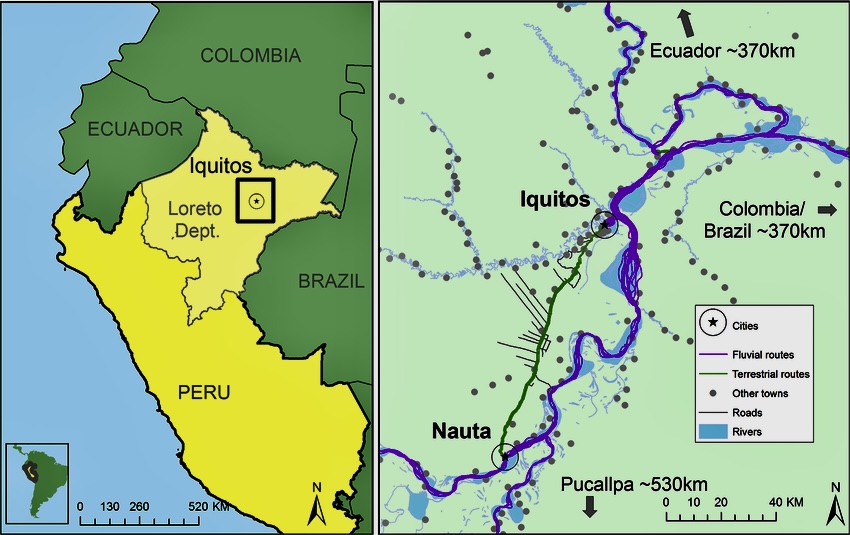
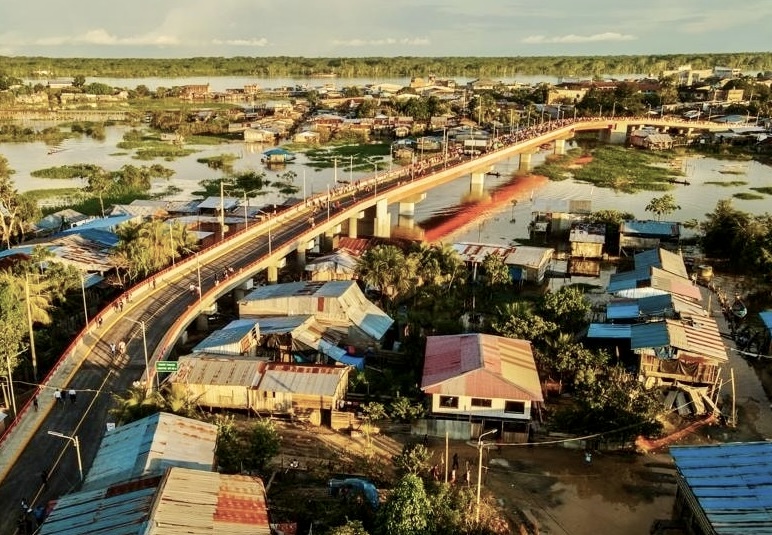
Left: This is the only paved road in town. Why was it built? To transport rubber and timber to the Iquitos port for shipping.
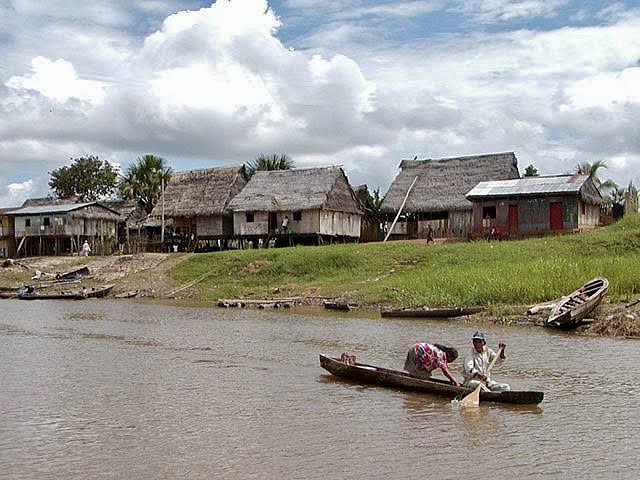
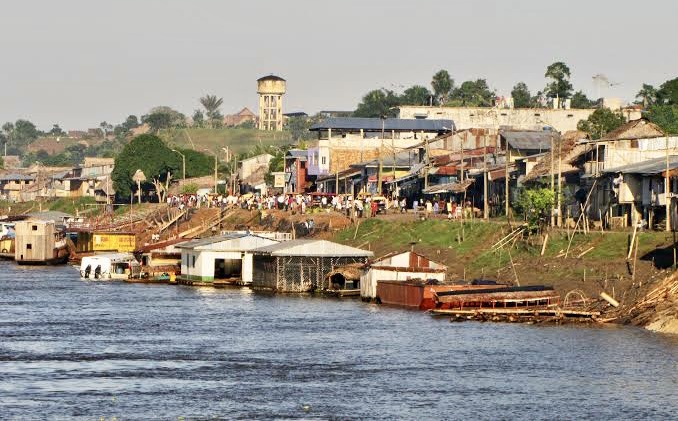
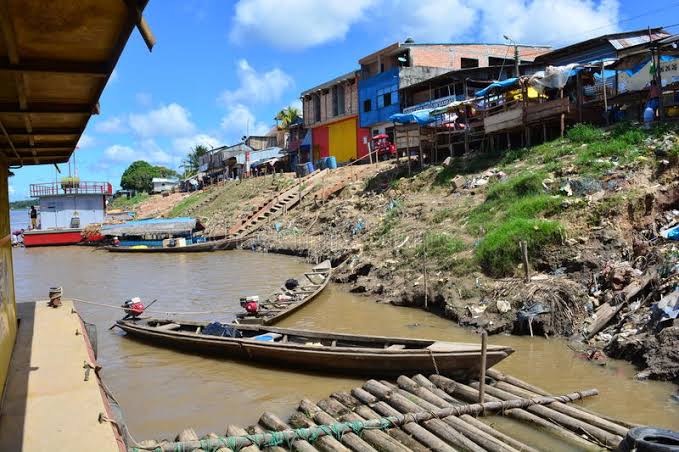
Ah Wilderness! – The Amazon
As part of his Iquitos adventure, this writer took the Iquitos-Nauta highway and cruised into Nauta with his tour guide, Javier. They embarked from Nauta on their four day Amazon River adventure. All together, four people travelled on a twenty foot long, extra-large canoe powered by a 15 hp outboard motor. The ship manifest listed the boat caption, Javier, his assistant and two tourist passengers. What a blast! Here are some of the highlights:
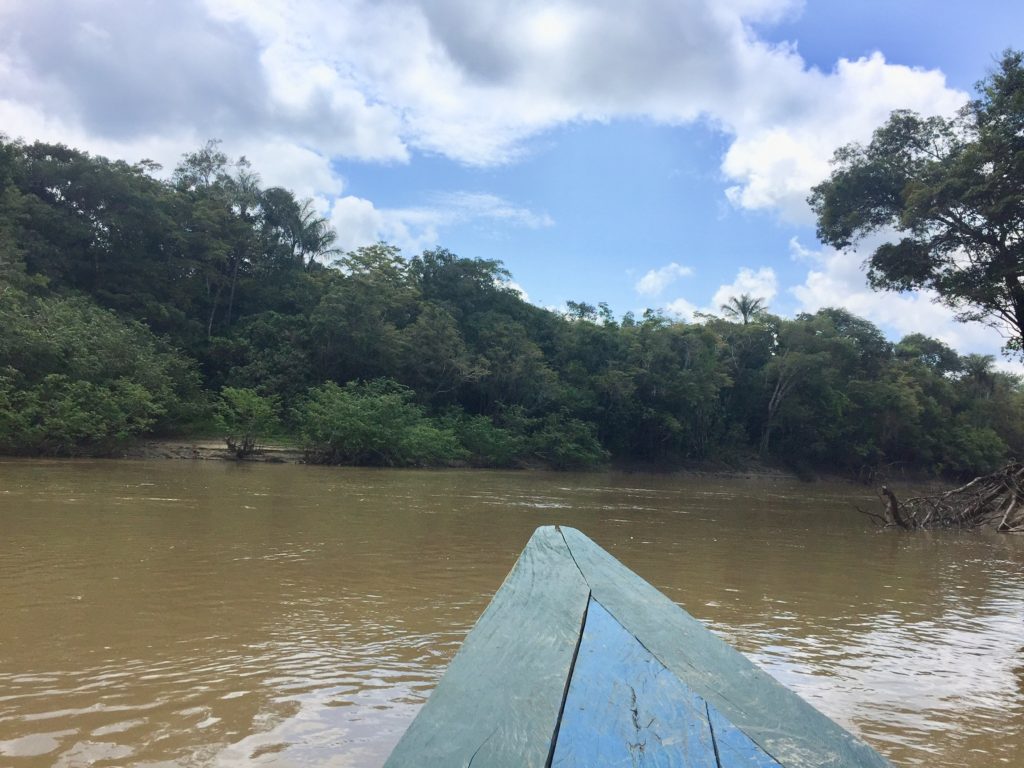
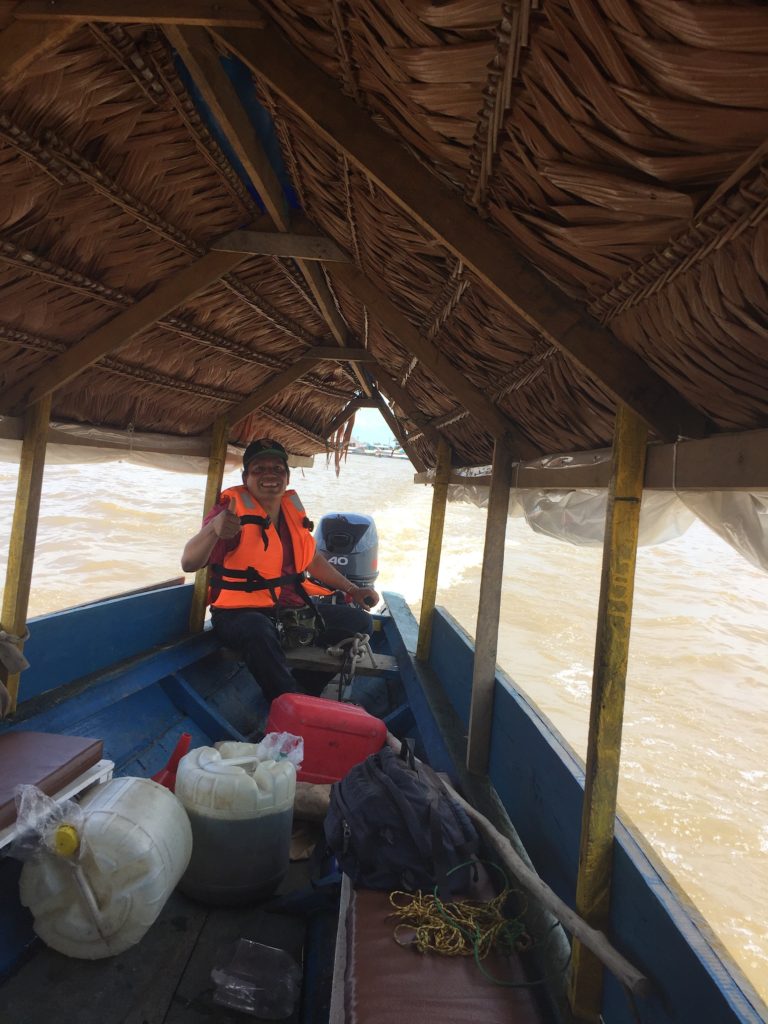
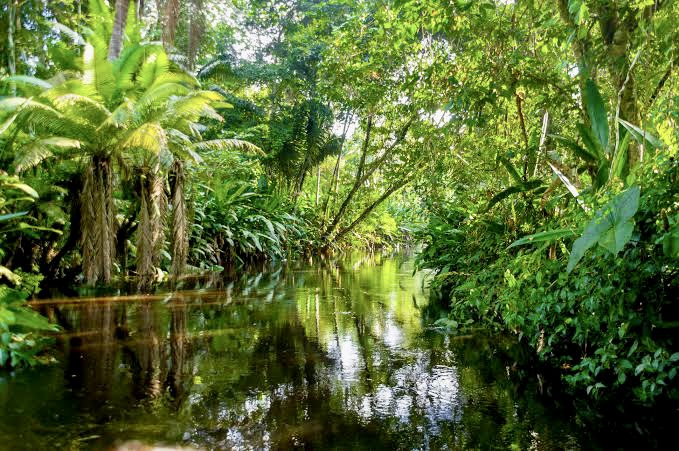
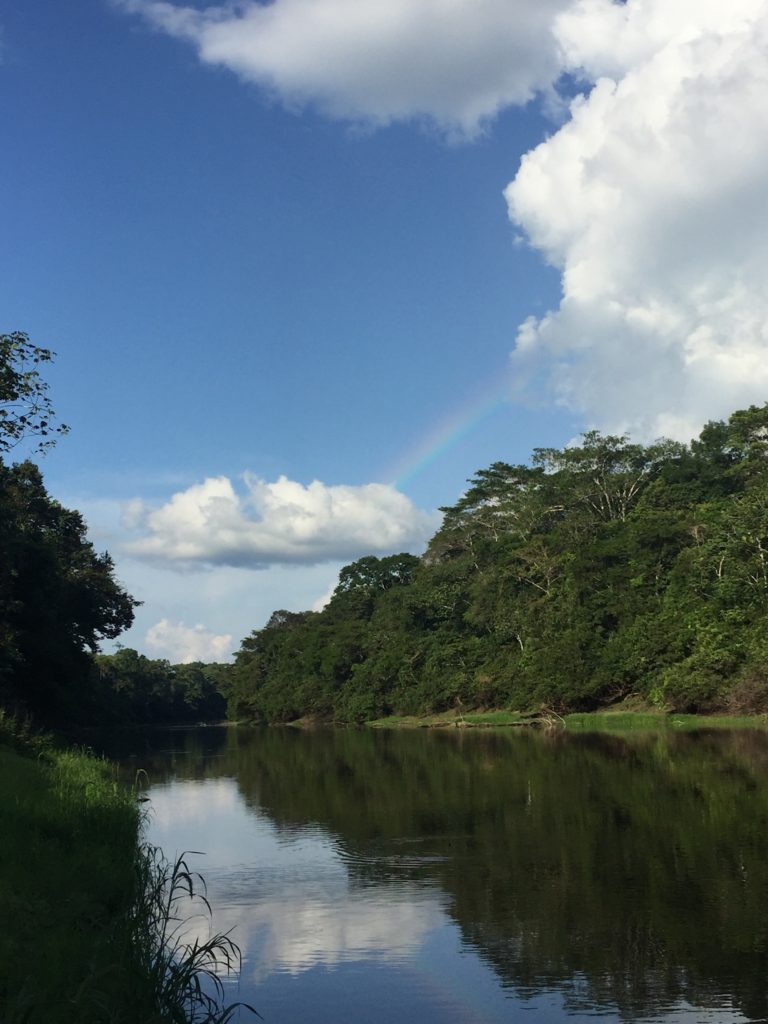

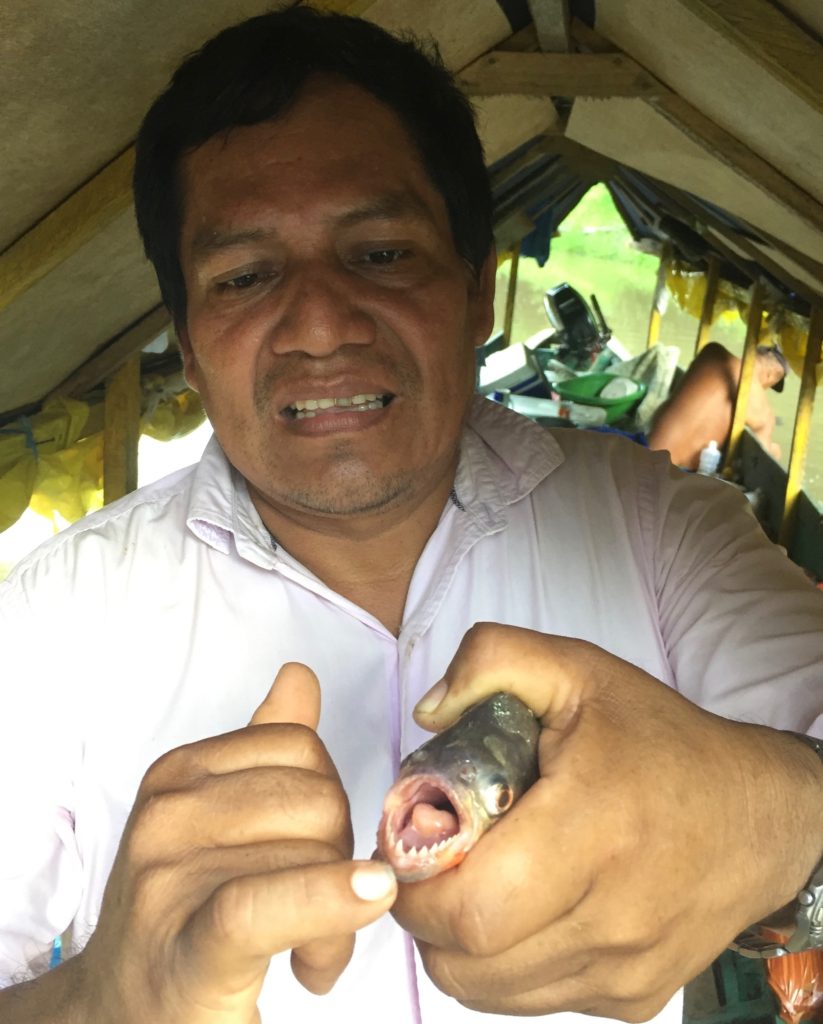
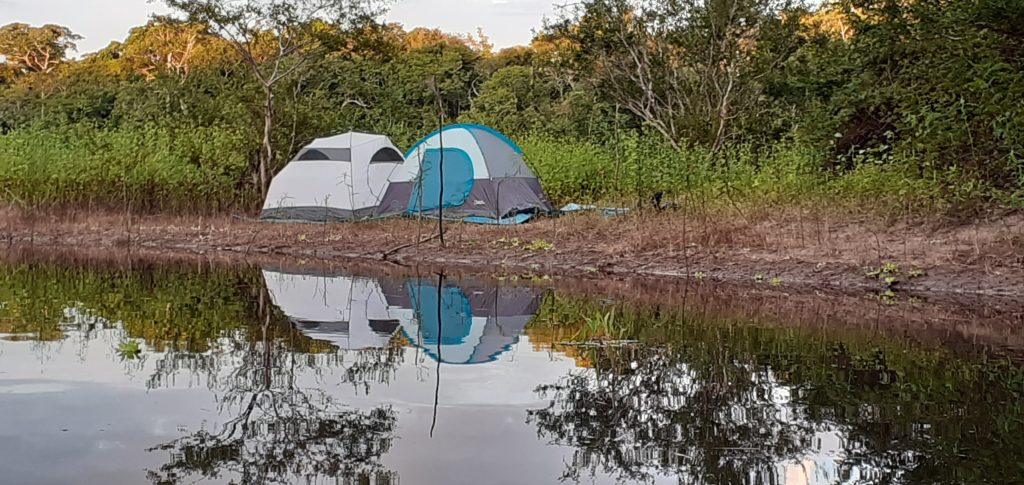
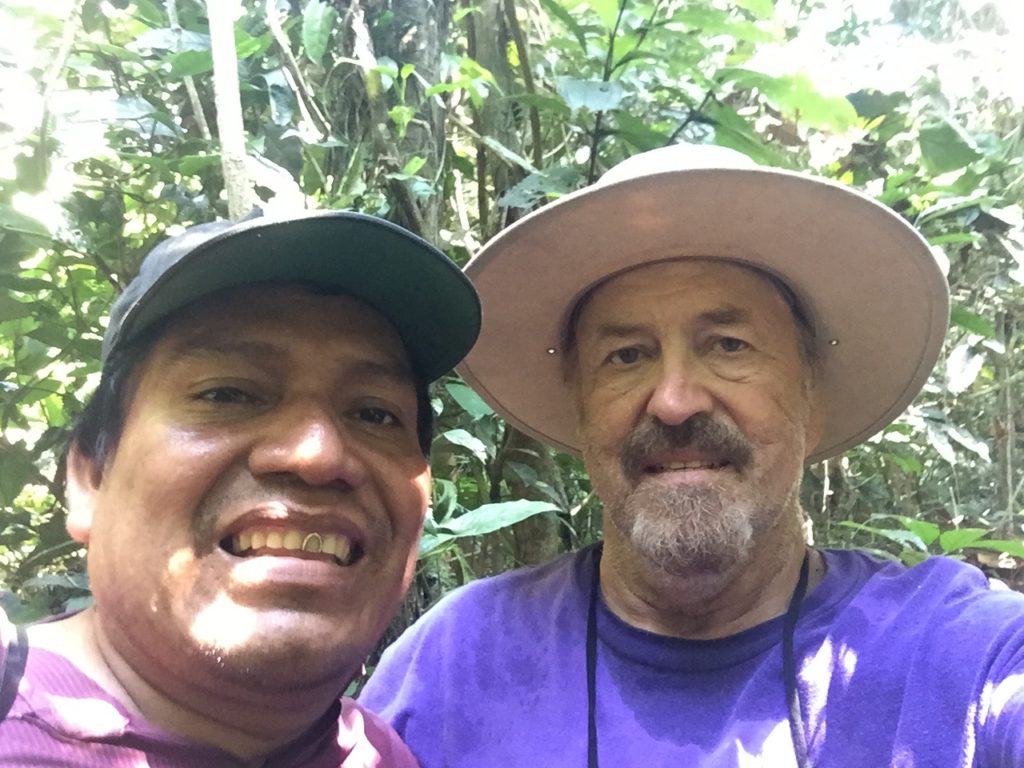
A Bonus Bird – Victor Diaz!

MY NAME IS NOW VICTOR DIAZ
Victor is this writer’s given middle name. When traveling around Peru, Zephyr Victor Carlyle presented his passport to check into hotels, as common with all foreign guests At the first two hotels, the clerks studied his passport and frowned. They both said do not go by the name Zephyr – it is too complicated (they had a point.) The clerks said use Victor. Turns out, Victor is a common, but proudly used, local name. The writer followed the local flow. From then on, he introduced himself as “Victor.” Turns out, there is a well-known, little bird in the Amazon named Victor. Actually, the birds’ chirp or call, sounds just like the stupid bird is saying the name “Victor Diaz.” Not surprisingly, Victor Diaz is the full local name given to this local bird. Naturally, with a great deal of mirth, the writer’s full name became Victor Diaz to all his new local friends.

Shameless Plug. Please consider signing up for a FREE subscription to this website which is both a travelogue and literary journal. Notices of new postings will be sent to readers by email. If interested, please, SUBSCRIBE BELOW. Note: Your information will never be marketed, sold, or used in any way. The marketing of personal data is a horrible idea. It will never happen to readers enjoying this website.
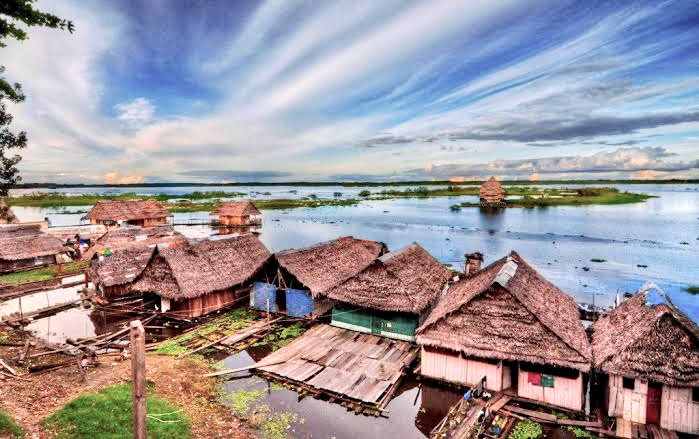
Pingback: A Lost 2019 Letter From Huanchaco – Lovely Peru During a Lousy Lockdown – Temples, Textiles and Tribes